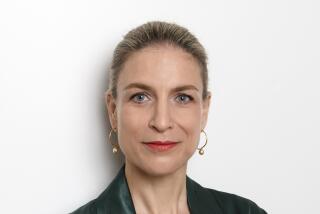Curator Leaves OCMA Bigger, More Diverse
- Share via
The recent resignation of the Orange County Museum of Art’s chief curator was given no explanation by museum officials Friday.
Bruce Guenther’s resignation, which he submitted a week ago, came as a surprise to museum staff and board trustees, OCMA director Naomi Vine said Friday. She added that he left under “very friendly terms” but would not elaborate on the specifics of his departure or his plans.
“We’re going to miss him, and we wish him well,” Vine said. “He has been with the museum through thick and thin.”
Guenther, 51, joined the Newport Harbor Art Museum in December 1991 after holding the same post at Chicago’s Museum of Contemporary Art for four years and contemporary art curator at the Seattle Art Museum from 1979 to 1987. He replaced highly regarded curator Paul Schimmel, who left Newport Harbor in 1989 for the Museum of Contemporary Art in Los Angeles.
Following Schimmel’s departure, and that of Newport Harbor director Kevin E. Consey the year before, for the top spot at the Museum of Contemporary Art in Chicago, the Newport museum shifted its focus away from cutting-edge shows that had earned it national respect in favor of heightened educational outreach efforts and shows with broader appeal.
It was also during the tenure of Guenther and Consey’s successor, Michael Botwinick, that ambitious plans fizzled for a major expansion of Newport Harbor onto a 10-acre land parcel facing Pacific Coast Highway, which was donated by developer Donald Bren, and with a new building for which renowned Italian architect Renzo Piano had been hired to design. A downturn in the Southern California economy during the early ‘90s was blamed for the change in that plan.
The museum remained in its small, longtime home on San Clemente Drive but later acquired the adjacent library space and in 1997 nearly doubled its size in a scaled-down expansion.
Guenther saw the Newport Harbor Museum through its controversial merger in 1996 with the Laguna Art Museum that formed OCMA. Among his priorities shortly after taking the chief curator post included efforts to reach a more ethnically diverse audience.
He is credited as one of many who helped bring about a financial turnaround for the museum, thanks mostly to that merger.
“He stuck with us during some tough times when our budgets were skinny,” said Charles D. Martin, chairman of OCMA’s board of trustees. “But now that OCMA is doing well, he was one major contributor. . . . The controversial [merger] was no fun for anyone. . . . He didn’t leave us when the chips were down, and that’s to his credit.”
Guenther could not be reached for comment Friday. Shortly before taking the chief curator post nearly eight years ago, he told The Times that change is inevitable.
“When you are involved in contemporary art,” he said, “there is a certain life expectancy with any institution for a curator. It’s important that you move, that you keep yourself off-balance.”
Highlights from Guenther’s stint with OCMA include the 1994 exhibit “The Essential Gesture”--an exhibit of contemporary sculpture that received mixed reviews. He also is credited as instrumental in the museum’s creation in 1997 of an Installation Gallery--designed to showcase one artist’s exhibit at a time.
Museum officials said that they will launch a national search for Guenther’s replacement but that the absence of a chief curator could be temporarily absorbed, as much of the work for upcoming exhibits is done.
“His are very big shoes to fill,” Martin said. “But it is an opportunity for OCMA to bring in some new and bold thinking. . . . I am sure that OCMA will find a world-class person to fill his shoes.”
Museum officials said Guenther will see through his work for the museum’s spring exhibit of Corona del Mar artist Tony DeLap.
Other exhibitions Guenther organized include a 1998 display of Mark di Suvero’s of large-scale sculptures in the greenbelt next to the Orange County Performing Arts Center and the 1996 oil-on-canvas exhibit by contemporary abstract artist Joe Goode.
More to Read
The biggest entertainment stories
Get our big stories about Hollywood, film, television, music, arts, culture and more right in your inbox as soon as they publish.
You may occasionally receive promotional content from the Los Angeles Times.










